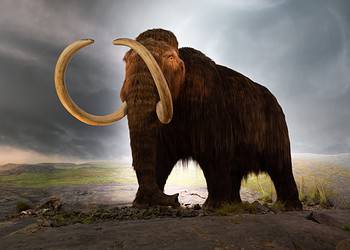
Scientists have discovered ancient fossil chromosomes preserved in a glass-like state in the skin of a 52,000-year-old female woolly mammoth that died near the Indigirka River in Siberia. While fragmentary wooly mammoth DNA has been extracted before, this is the first time that working chromosomes have been identified. It offers a treasure trove of genetic data on the colossal mammal, which some researchers are working to bring back from extinction.
“We’ve known that tiny fragments of ancient DNA can survive for long periods of time,” said Dr. Marcela Sandoval-Velasco of the University of Copenhagen’s Center for Evolutionary Hologenomics.
“But what we found here is a sample where the three-dimensional arrangement of these DNA fragments was frozen in place for tens of millennia, thereby preserving the structure of the whole chromosome.”
A Game-Changing Discovery

Chromosomes are threadlike structures composed entirely of DNA that reside in the cells of all living things. Each one of these biological databanks contains a wealth of genetic information that scientists can use to glean insights into the history and evolution of life on Earth. Normally, the remains of dead creatures degrade over time, causing DNA to fragment. Most ancient animal DNA discovered to date has been incomplete, often comprised of fewer than 100 base pairs out of the billions that once made up the full sequence of the organism.
However, the 52,000-year-old skin sample at the heart of this research was taken from behind the ear of a mammoth discovered in Northern Siberia in 2018. An intensive analysis of the sample revealed the presence of complete fossil chromosomes. These chromosomes, each measuring billionths of a meter in length, had seemingly been frozen in a glass-like state for tens of thousands of years. Knowing the shape of an organism’s chromosomes can help researchers to assemble entire DNA sequences of extinct creatures, a task previously deemed nearly impossible due to DNA degradation over time.
“This is a new type of fossil, and its scale dwarfs that of individual ancient DNA fragments — a million times more sequence,” explained Erez Lieberman Aiden, a corresponding author on the study and director of the Center for Genome Architecture at the Baylor College of Medicine.
Using a technique called PaleoHi-C, scientists identified that the mammoth had 28 chromosomes, similar to modern Asian elephants. However, significant differences were noted in genes related to hair growth, wound healing, and immune responses, which may explain the wooly mammoth’s shaggy appearance.
“Fossil chromosomes are a game-changer,” said Dr. Olga Dudchenko, co-first author of the study and assistant professor at the Baylor College of Medicine. “This enables the types of insights that would not have been possible before.”
Implications for De-Extinction

The half-life of DNA is just 521 years, making the preservation of long sequences extremely rare. Yet, the wooly mammoth’s chromosomes remained intact due to a process known as vitrification. This process, where materials fall below their glass transition temperature, preserved the chromosomes similarly to how foods like beef jerky and instant coffee are kept fresh.
Wild experiments conducted on freeze-dried beef jerky confirmed this preservation method works.
“We confirmed this theory by doing experiments on old, freeze-dried beef jerky, which is much easier to find than woolly mammoth jerky,” said Cynthia Pérez Estrada, co-first author of the study and a researcher at Rice University’s Center for Theoretical Biological Physics.
“We fired a shotgun at it. We ran over it with a car. We had a former starting pitcher for the Houston Astros throw a fastball at it. Each time, the jerky broke into tiny bits — shattering like a glass. But at the nano scale, the chromosomes were intact, unchanged. That’s the reason these fossils can survive. That’s the reason that they were there, 52,000 years later, just waiting for us to find them.”
Several research groups have an active interest in bringing the woolly mammoth back from extinction. In 2021, leading scientists in the field of genetics launched Colossal Biosciences, a bioscience startup funded with tens of millions of dollars on a mission to eventually breed a live mammoth hybrid. Other projects involving resurrecting other iconic extinct species, including the heath hens, and passenger pigeons are already underway and in the preliminary stages. A few other nominated animals are Stellar’s sea cow, the Tasmanian tiger, gastric brooding frog, dodo, and the Carolina parakeet.
“These results have obvious consequences for contemporary efforts aimed at woolly mammoth de-extinction,” commented Dr. Thomas Gilbert, director of the Center for Hologenomics at the University of Copenhagen. Both Gilbert and Aiden serve as advisors to Colossal Biosciences.
Moving forward, scientists hope that similar fossil chromosomes could be discovered in other specimens.
“Ancient Egyptian priests believed that mummification prepared a person or animal to be reanimated in a future life,” the scientists wrote in their study published in the journal Cell. “They may have been closer to the mark than has been realized.”






